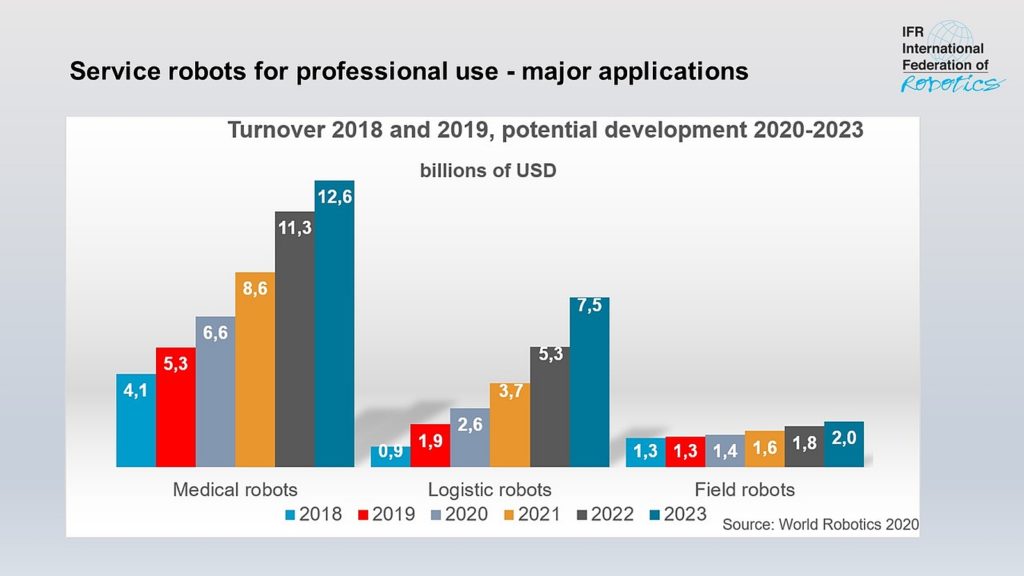| • Logistics Robots up 110% • Medical Robots up 28% |

| Frankfurt, October 28th, 2020 – Sales value of professional service robots increased by 32% to 11.2 billion U.S. dollars worldwide (2018-2019). The COVID-19 pandemic will further boost the market. High demand for robotics disinfection solutions, robotic logistics solutions in factories and warehouses or robots for home delivery are examples of this trend. This is according to World Robotics 2020 – Service Robots report, presented by the International Federation of Robotics (IFR). In terms of value, the sales of medical robotics accounts for 47% of the total professional service robot turnover in 2019. This was mainly driven by robotic surgery systems, which are the most expensive type in the segment. Sales hit a new record of 5.3 billion U.S. dollars – up 28%. By 2022, medical robot sales have the potential to more than double by reaching 11.3 billion U.S. dollars. About 90% of medical robots are from American and European suppliers. Professional Service Robots – logistics The market value of logistics robots sold or leased was up 110% to 1.9 billion U.S. dollars. Almost all of the logistics turnover was generated with robots for indoor use. Autonomous mobile robots have initially been used in warehouses but with digitalization of production, they are also part of today’s smart factory. Therefore, a continued strong turnover growth of 40% or more per year seems possible. “The investment in service robots for logistics in manufacturing processes is amortized rapidly,” says IFR President Milton Guerry. “Assuming 24 hour operation, the investment in service robots for logistics may be repaid within 2‐3 years and often much quicker. Given a 15 year lifetime, operating costs are around 5% of the annual investment. Highly developed systems often provide operational availability in the 98% plus range.” The trending Robotics-as-a-Service (RaaS) business models lower the hurdle for customers to automate with robots. The benefit is not to invest in hardware, so the companies have no fixed capital, no fixed costs and no need for robot operators. The use of logistics systems in non-manufacturing industries has been strongly driven by warehouse solutions for major e-commerce companies. A strong potential can also be found in hospitals running their logistics with the help of professional service robots. In the segment of professional service robotics, about 90% of the sampled logistics robots were produced in Europe and North America – about 10% in Asia. Professional Service Robots – field The segment of field robotics consists of robots for agriculture, dairy, livestock farming and other field applications. Sales value increased by 3% to USD 1.3 billion U.S. dollars. The Covid-19 pandemic might have an impact for further supply of such robots. Travel restrictions for workers from Eastern Europe for instance, who usually travel to Western Europe in harvest season, caused a shortage of labour supply. Farmers might compensate this with the use of field robots. Sales value growth rates of more than 30% for agricultural robots seem possible. Personal and Domestic Service Robots Service robots for personal and domestic use, which are produced for a mass market, are mainly in the areas of household robots. This include vacuuming and floor cleaning robots, lawn-mowing robots or entertainment robots. The total number of service robots for personal and domestic use increased by 34% to more than 23.2 million units sold in 2019. The value was up 20% to 5.7 billion U.S. dollars. Unit prices for the two major segments, robot vacuums and toy robots, have been declining in recent years. Today, basic robot vacuums are already available for less than 100 U.S. dollars. 75% of the sampled domestic service robots – vacuum and floor cleaners, lawn mowers and other domestic robots – were produced by American companies in 2019. Asian companies had a share of 19% – European companies of 6%. A growing market is the use of assistance robots for elderly or handicapped persons. The estimated sales value increased by 17% to 91 million U.S. dollars. Numerous national research projects in many countries focus on this huge future market for service robots. In contrast to most entertainment robots, these robots are high-tech products. “We expect sales of both professional and personal service robots will continue to increase strongly,” says Milton Guerry, President of the International Federation of Robotics. |
